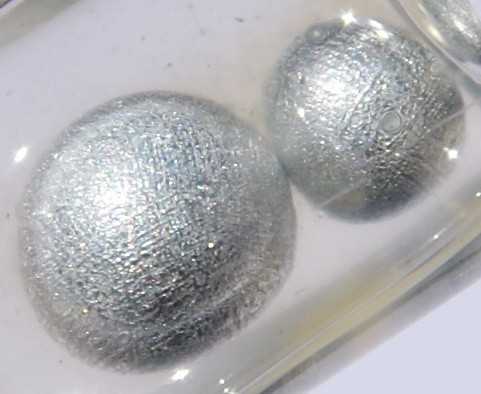Potassium is a chemical element with the symbol K and atomic number 19. Potassium is a silvery-white metal that is soft enough to be cut with a knife with little force. Potassium metal reacts rapidly with atmospheric oxygen to form flaky white potassium peroxide in only seconds of exposure.
Symbol: K
Atomic mass: 39.0983 u
Atomic number: 19
Van der Waals radius: 280 pm
Electronegativity: 0.82
Boiling point: 758.8 °C
Electron configuration: [Ar] 4s¹

SONY DSC
List of facts
Potassium is the chemical element with the symbol K
Potassium has the atomic number 19.
Potassium is a silvery-white metal that is soft enough to be cut with a knife with little force
Potassium metal reacts rapidly with atmospheric oxygen to form flaky white potassium peroxide in only seconds of exposure
Elemental potassium reacts vigorously with water, generating sufficient heat to ignite hydrogen emitted in the reaction, and burning with a lilac-colored flame
In the periodic table, potassium is one of the alkali metals
Potassium is chemically very similar to sodium, the previous element in group 1 of the periodic table.
The symbol K stems from kali, itself from the root word alkali, which in turn comes from Arabic: al-qalyah ‘plant ashes’
Potassium ions are vital for the functioning of all living cells
The transfer of potassium ions across nerve cell membranes is necessary for normal nerve transmission
Naturally occurring potassium is composed of three isotopes, of which 40K is radioactive
The English name for the element potassium comes from the word potash
When Humphry Davy first isolated the pure element using electrolysis in 1807, he named it potassium, which he derived from the word potash.
In 1814, the Swedish chemist Berzelius advocated the name kalium for potassium, with the chemical symbol K
Potassium is the second least dense metal after lithium.
Potassium reacts with oxygen, water, and carbon dioxide components in the air
With oxygen, it forms potassium peroxide.
With water potassium forms potassium hydroxide.
There are 25 known isotopes of potassium, three of which occur naturally: 39K (93.3%), 40K (0.0117%), and 41K (6.7%)
Potassium is formed in supernovae by nucleosynthesis from lighter atoms.
Potassium is principally created in Type II supernovae via an explosive oxygen-burning process.
Potassium is the 20th most abundant element in the solar system and the 17th most abundant element by weight in the Earth.
Potassium makes up about 2.6% of the weight of the Earth’s crust and is the seventh most abundant element in the crust
The potassium concentration in seawater is 0.39 g/L, about one-twenty-seventh the concentration of sodium
Granite contains 5% potassium
Potassium is the eighth or ninth most common element by mass (0.2%) in the human body
Potassium ions are present in a wide variety of proteins and enzymes
The British NHS recommends that adults need 3,500 mg per day and that excess amounts may cause health problems such as stomach pain and diarrhea
Foods with high potassium concentrations include yam, parsley, dried apricots, milk, chocolate, all nuts (especially almonds and pistachios), potatoes, bamboo shoots, bananas, avocados, coconut water, soybeans, and bran
A day’s worth of potassium is in 5 plantains or 11 bananas
Diets low in potassium can lead to hypertension and hypokalemia.
In 2020, potassium was the 33rd most commonly prescribed medication in the United States, with more than 17 million prescription
A meta-analysis concluded that a 1640 mg increase in the daily intake of potassium was associated with a 21% lower risk of stroke
The principal source of potassium – potash – is mined in Canada, Russia, Belarus, Kazakhstan, Germany, Israel, the United States, Jordan, and other places around the world
Potassium salts such as carnallite, langbeinite, polyhalite, and sylvite form extensive evaporite deposits in ancient lake bottoms and seabeds
The water of the Dead Sea is used by Israel and Jordan as a source of potash
Agricultural fertilizers consume 95% of global potassium chemical production, and about 90% of this potassium is supplied as KCl – Potassium Chloride
A depletion of potassium from the body can lead to hypokalemia, which can be fatal.
Properties
Physical properties |
|
|---|---|
| Phase at STP | solid |
| Melting point | 336.7 K (63.5 °C, 146.3 °F) |
| Boiling point | 1030.793 K (757.643 °C, 1395.757 °F) |
| Density (near r.t.) | 0.89 g/cm3 |
| when liquid (at m.p.) | 0.82948 g/cm3 |
| Critical point | 2223 K, 16 MPa |
| Heat of fusion | 2.33 kJ/mol |
| Heat of vaporization | 76.9 kJ/mol |
| Molar heat capacity | 29.6 J/(mol·K) |
Atomic properties |
|
| Oxidation states | −1, +1 (a strongly basic oxide) |
| Electronegativity | Pauling scale: 0.82 |
| Ionization energies |
|
| Atomic radius | empirical: 227 pm |
| Covalent radius | 203±12 pm |
| Van der Waals radius | 275 pm |
|
|
|
Other properties |
|
| Natural occurrence | primordial |
| Crystal structure | body-centered cubic (bcc) |
| Speed of sound thin rod | 2000 m/s (at 20 °C) |
| Thermal expansion | 83.3 µm/(m⋅K) (at 25 °C) |
| Thermal conductivity | 102.5 W/(m⋅K) |
| Electrical resistivity | 72 nΩ⋅m (at 20 °C) |
| Magnetic ordering | paramagnetic |
| Molar magnetic susceptibility | +20.8×10−6 cm3/mol (298 K) |
| Young’s modulus | 3.53 GPa |
| Shear modulus | 1.3 GPa |
| Bulk modulus | 3.1 GPa |
| Mohs hardness | 0.4 |
| Brinell hardness | 0.363 MPa |
| CAS Number | 7440-09-7 |
